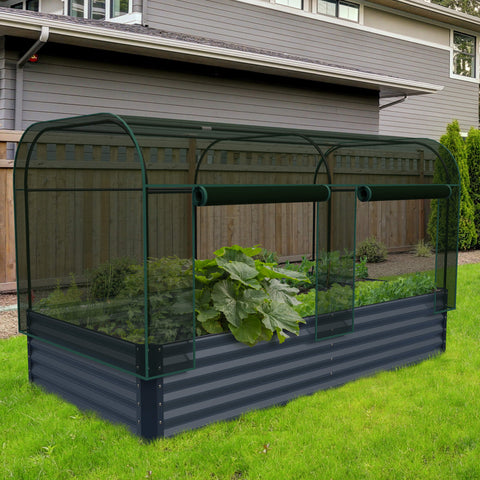Use these tips to help your perennials, trees, shrubs, and other plants survive the colder months. In spring, your plants will grow stronger. The following content also has some reference value for raised garden beds.
As fall temperatures drop, it's time to start preparing your garden for winter. As the weather gets colder, there seems to be little activity in your yard. Before the soil freezes, however, a lot can happen. This is especially true for newly planted trees and shrubs, perennials and hardy spring bulbs, all of which are busy growing roots and anchoring themselves to the ground. Earthworms and soil microbes are also at work, processing organic material into nutrients that plants need.

While nature has its own ways of dealing with colder months, there are a few things you can do to help prepare your plants for winter.
- Mulch your perennials
Perennials will come back every year, as long as they're hardy where you live. Hardy plants don't require much effort on your part to prepare for winter. But if your area gets a lot of freezing and thawing through the season, watch out for frost heaving. That means the soil can actually push plants out of the ground, especially new ones that don't yet have many roots. To prevent this, once the ground freezes, add a 6-inch layer of chopped leaves, straw, or other mulch around perennials. This will help regulate the soil temperature, especially if you're in an area where snow doesn't always cover the ground in winter.
Sometimes the dead leaves of this plant help protect its crown and roots from the cold, so save them until next spring when preparing your garden for winter. Many perennials (such as sedums, ornamental grasses) look beautiful in winter. In addition, their seeds feed birds and other wildlife.
If you prefer a tidier garden, cutting perennials to the ground after frost has wilted the leaves is fine. Be sure to add a layer of mulch to protect them.
- Protect annuals from frost
Unlike perennials that return each year, annuals live only one season in the garden and can't survive freezing temperatures. Some are known as cool-season annuals, meaning they prefer to grow and bloom when temperatures are cooler. Some are called cold-season annuals, which means they prefer to grow and bloom when temperatures are cooler. These include decorative kale, blue lobelia and goldfish. Warm-season annuals, on the other hand, prefer hot weather. Zinnias, French calendulas and impatiens all fall into this category.
You can extend the life of both annuals by covering them in light frosts with old sheets or floating row sets ($10, Home Depot). Keep watering annuals until freezing temperatures kill them. If your annuals are in containers, move them to a garage or other protected area when forecast overnight temperatures drop into the 40s. You can do this until the daytime temperature no longer exceeds this threshold.

3 Dig out soft bulbs
Autumn is the time to plant hardy spring flower bulbs, but there are other types of plants called tender bulbs. These include popular summer flowering plants such as gladiolus, canna and dahlia. If you live where the ground is frozen, these tropical plants won't survive the winter. But if you want to keep the plants for another year, you can bring them indoors.
Wait until the frost turns the leaves brown, gently dig out the bulbs or tubers. Cut off the leaves and brush off as much soil as possible. Avoid washing with water, as moisture can cause bulbs to rot during storage. Instead, let them dry in a cool place for a week or so.
Label them so you can remember what they are. One trick is to write names on them with a permanent marker ($2, Home Depot), as shown in the dahlia tuber. Then, pack them in a breathable container, such as a cardboard box. Cover them with sawdust or old newspaper so the bulbs don't touch, and store them in a garage, basement, or other place where the temperature is below 45 degrees but doesn't freeze.
- Pet trees and shrubs
If you can make sure the trees and shrubs are in good condition, they will have an easier time getting through the winter. One of the most important things for evergreen and deciduous plants is to give them plenty of water before the ground freezes, especially in the fall when it's dry. After the ground freezes, layer organic material, such as chopped leaves, up to 6 inches thick. This helps hold water in the soil (plants need water even in winter) and protects roots from freeze-thaw. Trim damaged or diseased limbs to prevent snow and snow from exacerbating these problems. For young evergreens that grow outdoors, cover them with burlap or shade cloth to protect against dry winter winds.
- Bundle the roses
Roses are so beautiful that it is hard to be stingy with their attention throughout the growing season. With cooler weather heading into their hibernation period, you have one last job to do: get them ready for winter. Some types of roses are hardier than others, so it's worth knowing which types you own. As a group, hybrid tea roses are the most susceptible to winter cold and require the most preparation; the easiest roses to plant and care for are bush roses.
Make sure to water all roses before the ground freezes, but do not fertilize or prune them. To protect the root ball from frost heave, pile more soil around the roots.










